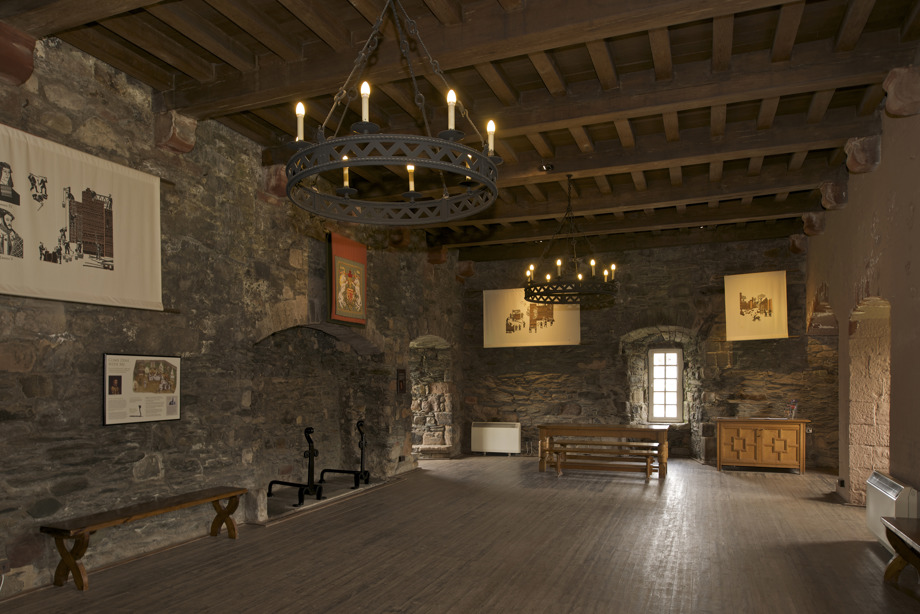Rothesay Castle on the Isle of Bute is unique among Scottish castles for both its early date and unusual circular plan. It’s also famous for its close links with the Stewarts – both while they were hereditary high stewards and, from 1371, a royal dynasty.
'The Bluidy Stair' was Walter Scott’s tale of love, hate, and murder at the castle.
Scott’s writings often reflected local stories and legends. This tale evokes Rothesay Castle’s early role as a frontier fortress, caught between the Kingdom of Scotland to the east, and the Lordship of the Isles to the west.
Listen to 'The Bluidy Stair'
Listen to the poem to discover what happens when Isabel, Lady of Rothesay, turns down the advances of Roderic, Lord of Bute (also known as Rory Mhor), who is said to have killed her father and three brothers.
Read 'The Bluidy Stair'
Oh, Rothesay’s tower is round about,
And Rothesay’s tower is strang;
And loud within its merry wa’s
The noise o’ wassail rang.
A scald o’ Norway struck the harp,
And a good harper was he;
For hearts beat mad, and looks grew wild
Wi’ his sang o’ victory.
A dark-eyed chief has left the board
Where he sat as lord and liege;
And he called aloud amidst the crowd
For Thorfinn, his little foot-page.
‘Go, tell the stranger Isabel,
That she stir not from the bower
Till darkness dons her blackest dress
And midnicht the hour.
‘And tell the Lady Isabel,
To come when the feast is o’er,
To meet upon the chapel stair
The chieftain of Rory Mhor.’
Like a shot star in a storm;
And a heart was felt to writhe, as if bit
By the never-dying worm.
A struggle was heard on the chapel stair,
And a smothered shriek of pain –
A deadened groan, and a fall on the stone –
And all was silent again.
The morning woke on the lady’s bower,
But no Isabel was there;
The morning woke on Rothesay’s tower,
And blood was on the stair.
And rain may fa’, and time may ca’
Its lazy wheels about;
But the steps are red, and the stains o’ bluid
Will never be washed out.
And oft in the mirk and midnicht hour,
When a’ is silent there,
A shriek is heard, and a lady is seen
On the steps of the bluidy stair.
An eye micht be seen wi’ revenge to gleam,
When the feast was o’er, and a’ was hushed
In midnicht and in mirk,
A lady was seen, like a spirit at e’en,
To pass by the holy kirk.
She stood at the foot o’ the chapel stair,
And she heard a footstep’s tread;
For the wild Norse warrior was there,
Who thus to the lady said:
‘I’m Rory Mhor, the island chief,
I’m Roderic, Lord of Bute;
For the raven o’ Norway flies above,
And the lion o’ Scotland is mute.
‘I hate your kith, fair lady,’ he said,
‘I hate your kith and kin;
And I am sworn to be their foe
Till life be dried within.
‘Yet kiss me, lovely Isabel,
And lay your cheek to mine;
Though ye bear the bluid o’ the High Steward,
I’ll woo nae hand but thine.’
‘Awa, awa! Ye rank butcher!’
Said the Lady Isabel,
‘For beneath your hand my father dear
And my three brave brothers fell.’
‘It’s I ha’e conquered them,” he said,
‘And I will conquer thee’
For if in love ye winna wed,
My leman ye shall be.’
‘The stars will dreip out their beds o’ blue
Ere you in love I wed;
I rather wad fly to the grave and lie
In the mouldy embrace o’ the dead.
‘I canna love, I winna love
A murderer for my lord;
For even yet my father’s bluid
Lies lapper’d on your sword.
‘And I never will be your base leman,
While death to my dagger is true;
For I hate you, Chief, as the foe of my kin,
And the foe of my country too.’
Sir Walter Scott - Celebrating 250 Years
In 2021-22, Scotland celebrates the 250th anniversary of one of its most famous sons, Sir Walter Scott. This online exhibition and audio trail of his legacies is part of the celebrations.
'The Bluidy Stair' has been performed by Edinburgh actor Gavin Paul, who is looking forward to visiting some of these important historical sights.




